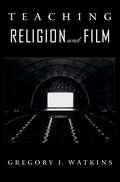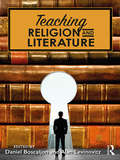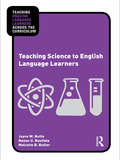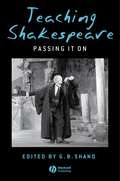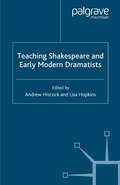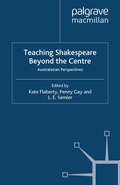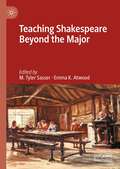- Table View
- List View
Teaching Reading to Every Child
by Douglas Fisher James Flood Diane Lapp Cynthia H. BrockThis popular text, now in its Fourth Edition, introduces pre-service and in-service teachers to the most current theories and methods for teaching literacy to children in elementary schools. The methods presented are based on scientific findings that have been tested in many classrooms. A wealth of examples, hands-on activities, and classroom vignettes--including lesson plans, assessments, lists of children's literature books to fiction and nonfiction texts, and more--illustrate the methods and bring them to life.The text highlights the importance of teaching EVERY child to become competent in all of the nuances and complexities of reading, writing, and speaking.The value of reflection and peer discussion in learning to expand their students' literacies is emphasized. Readers are encouraged to reflect on their own experiences with reading and teaching throughout their lifetimes--experiences that will serve well in learning to teach reading. "Your Turn" boxes invite readers to think about their views of the material presented, and to talk with colleagues and teachers about their "best ways" of learning this new information. "Did You Notice?" boxes engage readers in observation and analysis of methods and classroom situations discussed in the text. Teachers' stories serve as models of successful teaching and to draw readers into professional dialogue about the ideas and questions raised. End-of-chapter questions and activities provide additional opportunities for reflection and discussion. All of these pedagogical features help readers expand and refine their knowledge in the most positive ways.Topics covered in Teaching Reading to Every Child, Fourth Edition:*Getting to Know Your Students as Literacy Learners;*Looking Inside Classrooms: Organizing Instruction;*Assessing Reading Achievement;*The Importance of Oral Language in Developing Literacy;*Word Identification Strategies: Pathways to Comprehension;*Vocabulary Development;*Comprehension Instruction: Strategies At Work;*Content Area Learning;*What the Teacher Needs to Know to Enable Students' Text Comprehension;*Writing: Teaching Students to Encode and Compose;*Discovering the World Through Literature;*Technology and Media in Reading;*Teaching Reading to Students Who Are Learning English;*All Students are Special: Some Need Supplemental Supports and Services to Be Successful; and*Historical Perspectives on Reading and Reading Instruction.New in the Fourth Edition:*A new chapter on technology with state-of-the-art applications;*A new chapter with the most up-to-date information on how vocabulary is learned and on how it is best taught, responding to the national renewed interest in vocabulary instruction;*A new section on Readers/Writer's workshop with a focus on supporting student inquiry and exploration of multiple genres;*A more comprehensive chapter on literature instruction and the role of literature in the reading program with examples that support students' multigenre responses;*A discussion of literary theories with examples for classroom implementation;*Broader coverage of the phases of reading development from the pre-alphabetic stage to the full alphabetic stage;*A more inclusive chapter on writing instruction; and*A thoroughly revised chapter on teaching reading to students who are learning English, including extensive information on assessment and evaluation.
Teaching Reading to Every Child
by Diane Lapp James Flood Cynthia H. Brock Douglas FisherThis popular text, now in its Fourth Edition, introduces pre-service and in-service teachers to the most current theories and methods for teaching literacy to children in elementary schools. The methods presented are based on scientific findings that have been tested in many classrooms. A wealth of examples, hands-on activities, and classroom vignettes--including lesson plans, assessments, lists of children's literature books to fiction and nonfiction texts, and more--illustrate the methods and bring them to life.The text highlights the importance of teaching EVERY child to become competent in all of the nuances and complexities of reading, writing, and speaking.The value of reflection and peer discussion in learning to expand their students' literacies is emphasized. Readers are encouraged to reflect on their own experiences with reading and teaching throughout their lifetimes--experiences that will serve well in learning to teach reading. "Your Turn" boxes invite readers to think about their views of the material presented, and to talk with colleagues and teachers about their "best ways" of learning this new information. "Did You Notice?" boxes engage readers in observation and analysis of methods and classroom situations discussed in the text. Teachers' stories serve as models of successful teaching and to draw readers into professional dialogue about the ideas and questions raised. End-of-chapter questions and activities provide additional opportunities for reflection and discussion. All of these pedagogical features help readers expand and refine their knowledge in the most positive ways.Topics covered in Teaching Reading to Every Child, Fourth Edition:*Getting to Know Your Students as Literacy Learners;*Looking Inside Classrooms: Organizing Instruction;*Assessing Reading Achievement;*The Importance of Oral Language in Developing Literacy;*Word Identification Strategies: Pathways to Comprehension;*Vocabulary Development;*Comprehension Instruction: Strategies At Work;*Content Area Learning;*What the Teacher Needs to Know to Enable Students' Text Comprehension;*Writing: Teaching Students to Encode and Compose;*Discovering the World Through Literature;*Technology and Media in Reading;*Teaching Reading to Students Who Are Learning English;*All Students are Special: Some Need Supplemental Supports and Services to Be Successful; and*Historical Perspectives on Reading and Reading Instruction.New in the Fourth Edition:*A new chapter on technology with state-of-the-art applications;*A new chapter with the most up-to-date information on how vocabulary is learned and on how it is best taught, responding to the national renewed interest in vocabulary instruction;*A new section on Readers/Writer's workshop with a focus on supporting student inquiry and exploration of multiple genres;*A more comprehensive chapter on literature instruction and the role of literature in the reading program with examples that support students' multigenre responses;*A discussion of literary theories with examples for classroom implementation;*Broader coverage of the phases of reading development from the pre-alphabetic stage to the full alphabetic stage;*A more inclusive chapter on writing instruction; and*A thoroughly revised chapter on teaching reading to students who are learning English, including extensive information on assessment and evaluation.
Teaching Religion and Film (An American Academy of Religion Book)
by Gregory J WatkinsIn a culture increasingly focused on visual media, students have learned not only to embrace multimedia presentations in the classroom, but to expect them. Such expectations are perhaps more prevalent in a field as dynamic and cross-disciplinary as religious studies, but the practice nevertheless poses some difficult educational issues -- the use of movies in academic coursework has far outpaced the scholarship on teaching religion and film. What does it mean to utilize film in religious studies, and what are the best ways to do it? In Teaching Religion and Film, an interdisciplinary team of scholars thinks about the theoretical and pedagogical concerns involved with the intersection of film and religion in the classroom. They examine the use of film to teach specific religious traditions, religious theories, and perspectives on fundamental human values. Some instructors already teach some version of a film-and-religion course, and many have integrated film as an ancillary to achieving central course goals. This collection of essays helps them understand the field better and draws the sharp distinction between merely "watching movies" in the classroom and comprehending film in an informed and critical way.
Teaching Religion and Literature
by Daniel Boscaljon Alan LevinovitzTeaching Religion and Literature provides a practical engagement with the pedagogical possibilities of teaching religion courses using literature, teaching literature classes using religion, and teaching Religion and Literature as a discipline. Featuring chapters written by award winning teachers from a variety of institutional settings, the book gives anyone interested in providing interdisciplinary education a set of questions, resources, and tools that will deepen a classroom’s engagement with the field. Chapters are grounded in specific texts and religious questions but are oriented toward engaging general pedagogical issues that allow each chapter to improve any instructor’s engagement with interdisciplinary education. The book offers resources to instructors new to teaching Religion and Literature and provides definitions of what the field means from senior scholars in the field. Featuring a wide range of religious traditions, genres, and approaches, the book also provides an innovative glimpse at emerging possibilities for the sub-discipline.
Teaching Religion and Literature
by Daniel Boscaljon Alan LevinovitzTeaching Religion and Literature provides a practical engagement with the pedagogical possibilities of teaching religion courses using literature, teaching literature classes using religion, and teaching Religion and Literature as a discipline. Featuring chapters written by award winning teachers from a variety of institutional settings, the book gives anyone interested in providing interdisciplinary education a set of questions, resources, and tools that will deepen a classroom’s engagement with the field. Chapters are grounded in specific texts and religious questions but are oriented toward engaging general pedagogical issues that allow each chapter to improve any instructor’s engagement with interdisciplinary education. The book offers resources to instructors new to teaching Religion and Literature and provides definitions of what the field means from senior scholars in the field. Featuring a wide range of religious traditions, genres, and approaches, the book also provides an innovative glimpse at emerging possibilities for the sub-discipline.
Teaching & Researching: Computer-Assisted Language Learning
by Ken BeattyComputers play a crucial and rapidly evolving role in education, particularly in the area of language learning. Far from being a tool mimicking a textbook or teacher, Computer-Assisted Language Learning (CALL) has the power to transform language learning through the pioneering application of innovative research and practices. Technological innovation creates opportunities to revisit old ideas, conduct new research and challenge established beliefs, meaning that the field is constantly undergoing change. This fully revised second edition brings teachers and researchers up-to-date by offering:A comprehensive overview of CALL and current research issuesStep-by-step instructions on conducting research projects in CALL Extensive resources in the form of contacts, websites and free software references A glossary of terms related to CALLClosely linked to other branches of study such as autonomy in language learning and computer science, CALL is at the cutting edge of current research directions. This book is essential reading for all teachers and researchers interested in using CALL to make language learning a richer, more productive and more enjoyable task. Ken Beatty has taught at colleges and universities in Canada, Asia and the Middle East. His publications include more than 100 textbooks for learning English as a Second Language, as well as various websites, CD-ROMs and educational videos.
Teaching & Researching: Computer-Assisted Language Learning
by Ken BeattyComputers play a crucial and rapidly evolving role in education, particularly in the area of language learning. Far from being a tool mimicking a textbook or teacher, Computer-Assisted Language Learning (CALL) has the power to transform language learning through the pioneering application of innovative research and practices. Technological innovation creates opportunities to revisit old ideas, conduct new research and challenge established beliefs, meaning that the field is constantly undergoing change. This fully revised second edition brings teachers and researchers up-to-date by offering:A comprehensive overview of CALL and current research issuesStep-by-step instructions on conducting research projects in CALL Extensive resources in the form of contacts, websites and free software references A glossary of terms related to CALLClosely linked to other branches of study such as autonomy in language learning and computer science, CALL is at the cutting edge of current research directions. This book is essential reading for all teachers and researchers interested in using CALL to make language learning a richer, more productive and more enjoyable task. Ken Beatty has taught at colleges and universities in Canada, Asia and the Middle East. His publications include more than 100 textbooks for learning English as a Second Language, as well as various websites, CD-ROMs and educational videos.
Teaching & Researching: Language Learning Strategies
by Rebecca L. OxfordOver the past thirty years, the field of language learning strategies has generated a massive amount of interest and research in applied linguistics. Teaching and Researching Language Learning Strategies redraws the landscape of language learning strategies at just the right time. In this book Rebecca Oxford charts the field systematically and coherently for the benefit of language learning practitioners, students, and researchers. Offering practical, innovative suggestions for assessing, teaching, and researching language learning strategies, she provides examples of strategies and tactics from all levels, from beginners to distinguished-level learners, as well as a new taxonomy of strategies for language learning. In demonstrating why self-regulated learning strategies are necessary for language proficiency, Oxford integrates socio-cultural, cognitive, and affective dimensions, and argues convincingly for the need for conceptual cross-fertilization. Providing clear and concise explanations of the advantages and limitations of the different approaches, this book is full of practical value and theoretical insights. The book is designed to guide the reader with the use of a range of features, including: key quotes and concept boxes preview questions and chapter overviews glossary and end-of-chapter further readings sources and resources section
Teaching & Researching: Language Learning Strategies
by Rebecca L. OxfordOver the past thirty years, the field of language learning strategies has generated a massive amount of interest and research in applied linguistics. Teaching and Researching Language Learning Strategies redraws the landscape of language learning strategies at just the right time. In this book Rebecca Oxford charts the field systematically and coherently for the benefit of language learning practitioners, students, and researchers. Offering practical, innovative suggestions for assessing, teaching, and researching language learning strategies, she provides examples of strategies and tactics from all levels, from beginners to distinguished-level learners, as well as a new taxonomy of strategies for language learning. In demonstrating why self-regulated learning strategies are necessary for language proficiency, Oxford integrates socio-cultural, cognitive, and affective dimensions, and argues convincingly for the need for conceptual cross-fertilization. Providing clear and concise explanations of the advantages and limitations of the different approaches, this book is full of practical value and theoretical insights. The book is designed to guide the reader with the use of a range of features, including: key quotes and concept boxes preview questions and chapter overviews glossary and end-of-chapter further readings sources and resources section
Teaching Romanticism (Teaching the New English)
by D. Higgins S. RustonRomanticism is taught at universities across the globe and is considered integral to the study of British and European literature. This book, written by leading academics, presents innovative, practical approaches to teaching traditional and newer aspects of the curriculum and is essential to anyone teaching Romanticism at university level.
Teaching Science Fiction (Teaching the New English)
by Andy Sawyer and Peter WrightTeaching Science Fiction is the first text in thirty years to explore the pedagogic potential of that most intellectually stimulating and provocative form of popular literature: science fiction. Innovative and academically lively, it offers valuable insights into how SF can be taught historically, culturally and practically at university level.
Teaching Science to English Language Learners: Preparing Pre-Service and In-Service Teachers
by Luciana C. de Oliveira and Kristen Campbell WilcoxThis edited collection explores how science can be taught to English language learners (ELLs) in 21st century classrooms. The authors focus on the ways in which pre-service and in-service science teachers have developed—or may develop—instructional effectiveness for working with ELLs in the secondary classroom. Chapter topics are grounded in both research and practice, addressing a range of timely topics including the current state of ELL education in the secondary science classroom, approaches to leveraging the talents and strengths of bilingual students in heterogeneous classrooms, best practices in teaching science to multilingual students, and ways to infuse the secondary science teacher preparation curriculum with ELL pedagogy. This book will appeal to an audience beyond secondary content area teachers and teacher educators to all teachers of ELLs, teacher educators and researchers of language acquisition more broadly.
Teaching Science to English Language Learners
by Joyce Nutta Nazan U. Bautista Malcolm B. ButlerBooks in the Teaching English Language Learners (ELLs) across the Curriculum Series are written specifically for pre- and in- service teachers who may not have been trained in ELL techniques, but still find themselves facing the realities and challenges of today's diverse classrooms and learners. Each book provides simple and straightforward advice on how to teach ELLs through a given subject area, and how to teach content to ELLs who are at different levels of English language proficiency than the rest of their class. Authored by both language and content area specialists, each volume arms readers with practical, teacher-friendly strategies, and subject-specific techniques. Teaching Science to English Language Learners offers science teachers and teacher educators a straightforward approach for engaging ELLs learning science, offering examples of easy ways to adapt existing lesson plans to be more inclusive. The practical, teacher-friendly strategies and techniques included here are proven effective with ELLs, and many are also effective with all students. The book provides context-specific strategies for the full range of the secondary sciences curriculum, including physical science, life science, earth and space science, science as inquiry, and history and nature of science and more. A fully annotated list of web and print resources completes the book, making this a one volume reference to help science teachers meet the challenges of including all learners in effective instruction. Special features: practical examples of science exercises make applying theory to practice simple when teaching science to ELLs an overview of the National Science Education Standards offers useful guidelines for effective instructional and assessment practices for ELLs in secondary grades graphs, tables, and illustrations provide additional access points to the text in clear, meaningful ways.
Teaching Science to English Language Learners
by Joyce Nutta Nazan U. Bautista Malcolm B. ButlerBooks in the Teaching English Language Learners (ELLs) across the Curriculum Series are written specifically for pre- and in- service teachers who may not have been trained in ELL techniques, but still find themselves facing the realities and challenges of today's diverse classrooms and learners. Each book provides simple and straightforward advice on how to teach ELLs through a given subject area, and how to teach content to ELLs who are at different levels of English language proficiency than the rest of their class. Authored by both language and content area specialists, each volume arms readers with practical, teacher-friendly strategies, and subject-specific techniques. Teaching Science to English Language Learners offers science teachers and teacher educators a straightforward approach for engaging ELLs learning science, offering examples of easy ways to adapt existing lesson plans to be more inclusive. The practical, teacher-friendly strategies and techniques included here are proven effective with ELLs, and many are also effective with all students. The book provides context-specific strategies for the full range of the secondary sciences curriculum, including physical science, life science, earth and space science, science as inquiry, and history and nature of science and more. A fully annotated list of web and print resources completes the book, making this a one volume reference to help science teachers meet the challenges of including all learners in effective instruction. Special features: practical examples of science exercises make applying theory to practice simple when teaching science to ELLs an overview of the National Science Education Standards offers useful guidelines for effective instructional and assessment practices for ELLs in secondary grades graphs, tables, and illustrations provide additional access points to the text in clear, meaningful ways.
Teaching Second Language Writing (The Routledge E-Modules on Contemporary Language Teaching)
by Charlene PolioThis module explores the purposes of and methods for teaching second language writing. Engaging and accessible, Teaching Second Language Writing is organized into three sections that mainly focus on activities, approaches and real-life writing tasks and genres that are the most applicable and useful for the language teaching classroom. -- The Routledge E-Book Modules on Contemporary Language Teaching introduce students to the major areas of second language instruction through jargon-free style and explain concepts as they are introduced thus facilitating comprehension for those with little or no background. The series consists of independent modules that can stand alone or be combined at the discretion of the reader or instructor. The modules can also be used as supplements to existing materials for maximum flexibility. Modules in this series include: Language (Bill VanPatten) Communication and Skill (Bill VanPatten) Second Language Acquisition: The Basics (Gregory D. Keating) Focusing on Form in Language Instruction (Wynne Wong and Daphnée Simard) Vocabulary in Language Teaching (Joe Barcroft) Interactive Tasks (Michael J. Leeser and Justin P. White) Technology in Language Learning: An Overview (Bryan Smith) Teaching Second Language Writing (Charlene Polio) Readers have the option to select and download electronically the 40-50 page modules for individual use, or to purchase multiple modules at once. With each module written by an expert in that respective field, with self-quizzes, reflection boxes, recommended readings, and discussion questions, these modules serve as the ideal text for introductory courses in Second Language Instruction. To purchase these modules and view module summaries, please visit the series companion website: www.routledgetextbooks.com/textbooks/9781315679594/
Teaching Second Language Writing (The Routledge E-Modules on Contemporary Language Teaching)
by Charlene PolioThis module explores the purposes of and methods for teaching second language writing. Engaging and accessible, Teaching Second Language Writing is organized into three sections that mainly focus on activities, approaches and real-life writing tasks and genres that are the most applicable and useful for the language teaching classroom. -- The Routledge E-Book Modules on Contemporary Language Teaching introduce students to the major areas of second language instruction through jargon-free style and explain concepts as they are introduced thus facilitating comprehension for those with little or no background. The series consists of independent modules that can stand alone or be combined at the discretion of the reader or instructor. The modules can also be used as supplements to existing materials for maximum flexibility. Modules in this series include: Language (Bill VanPatten) Communication and Skill (Bill VanPatten) Second Language Acquisition: The Basics (Gregory D. Keating) Focusing on Form in Language Instruction (Wynne Wong and Daphnée Simard) Vocabulary in Language Teaching (Joe Barcroft) Interactive Tasks (Michael J. Leeser and Justin P. White) Technology in Language Learning: An Overview (Bryan Smith) Teaching Second Language Writing (Charlene Polio) Readers have the option to select and download electronically the 40-50 page modules for individual use, or to purchase multiple modules at once. With each module written by an expert in that respective field, with self-quizzes, reflection boxes, recommended readings, and discussion questions, these modules serve as the ideal text for introductory courses in Second Language Instruction. To purchase these modules and view module summaries, please visit the series companion website: www.routledgetextbooks.com/textbooks/9781315679594/
Teaching Secondary English: Readings and Applications
by Daniel SheridanThis new edition of Teaching Secondary English is thoroughly revised, but its purpose has not changed. Like the popular first edition, it balances content knowledge with methodology, theory with practice, and problem-posing with suggested solutions. The tone and format are inviting, while addressing student-readers on a professional level. Rather than attempting to cover everything, the text provides a framework and materials for teaching a secondary English methods course, while allowing considerable choice for the instructor. The focus is on teaching literature, writing, and language--the basics of the profession. Attention is given to the issues that arise as one seeks to explore what it means to "teach English." The problems and tensions of becoming a teacher are discussed frankly, in a manner that helps students figure out their own attitudes and solutions. Features: * Focuses on a few central concepts in the teaching of secondary English * Provides an anthology of 22 readable and challenging essays on key topics--allowing students to hear a variety of voices and opinions * Includes an applications section for each reading that extends the discussion and asks students to explore problems and grapple with important issues related to the articles * Offers short writing assignments in questions that follow the readings and in brief writing tasks in the applications, and a longer writing assignment at the end of each chapter * Addresses student readers directly without talking down to them New in the Second Edition: * This edition is shorter, tighter, and easier to use. * The opening and concluding chapters more directly address the concerns of new teachers. * The anthology is substantially updated (of the 22 articles included, 14 are new to this edition). * Each essay is preceded by a brief introduction and followed by questions for further thought. * There are fewer applications, but these are more extensive and more fully integrated within the text. * A writing assignment is provided at the end of each chapter. * Interviews with college students--before and after student teaching--are included in Chapters 1 and 6. * The bibliographies at the end of each chapter are fully updated.
Teaching Secondary English: Readings and Applications
by Daniel SheridanThis new edition of Teaching Secondary English is thoroughly revised, but its purpose has not changed. Like the popular first edition, it balances content knowledge with methodology, theory with practice, and problem-posing with suggested solutions. The tone and format are inviting, while addressing student-readers on a professional level. Rather than attempting to cover everything, the text provides a framework and materials for teaching a secondary English methods course, while allowing considerable choice for the instructor. The focus is on teaching literature, writing, and language--the basics of the profession. Attention is given to the issues that arise as one seeks to explore what it means to "teach English." The problems and tensions of becoming a teacher are discussed frankly, in a manner that helps students figure out their own attitudes and solutions. Features: * Focuses on a few central concepts in the teaching of secondary English * Provides an anthology of 22 readable and challenging essays on key topics--allowing students to hear a variety of voices and opinions * Includes an applications section for each reading that extends the discussion and asks students to explore problems and grapple with important issues related to the articles * Offers short writing assignments in questions that follow the readings and in brief writing tasks in the applications, and a longer writing assignment at the end of each chapter * Addresses student readers directly without talking down to them New in the Second Edition: * This edition is shorter, tighter, and easier to use. * The opening and concluding chapters more directly address the concerns of new teachers. * The anthology is substantially updated (of the 22 articles included, 14 are new to this edition). * Each essay is preceded by a brief introduction and followed by questions for further thought. * There are fewer applications, but these are more extensive and more fully integrated within the text. * A writing assignment is provided at the end of each chapter. * Interviews with college students--before and after student teaching--are included in Chapters 1 and 6. * The bibliographies at the end of each chapter are fully updated.
Teaching Shakespeare: Passing It On
by G. B. ShandThis contemplative anthology offers personal essays by noted scholars on a range of topics related to the teaching of Shakespeare. Ideal for the graduate student, it addresses many of the primary concerns and rewards of the discipline, drawing on the variety of special skills, interests, and experiences brought to the classroom by the volume's distinguished contributors. Offers insight into the classroom practices, special skills, interests, and experiences of some of the most distinguished Shakespearean scholars in the field Features essayists who reflect on the experience of teaching Shakespeare at university level; how they approach the subject and why they think it is important to teach Provides anecdotal and practical advice for any reader interested in teaching the works of Shakespeare Engagingly candid
Teaching Shakespeare and Early Modern Dramatists (Teaching the New English)
by A. Hiscock L. HopkinsThis collection offers practical suggestions for the integration of non-Shakespearean drama into the teaching of Shakespeare. It shows both the ways in which Shakespearean drama is typical of its period and of the ways in which it is distinctive, by looking at Shakespeare and other writers who influenced and developed the genres in which he worked.
Teaching Shakespeare and Marlowe: Learning versus the System (Shakespeare Now!)
by Liam E. SemlerSchools and universities are fast becoming managerial 'courts' of learning in which educators and students are system creatures busily fulfilling system protocols. Any teacher or academic yearning for fresh and authentic approaches to their discipline must first find ways to imagine possibilities beyond the system's limits. This book sounds the depths of the problem in respect to Literary Studies and proposes strategies for effecting voluntary 'exile' from court in pursuit of more imaginative approaches to the teaching and learning of Shakespeare and Marlowe.
Teaching Shakespeare and Marlowe: Learning versus the System (Shakespeare Now!)
by Liam E. SemlerSchools and universities are fast becoming managerial 'courts' of learning in which educators and students are system creatures busily fulfilling system protocols. Any teacher or academic yearning for fresh and authentic approaches to their discipline must first find ways to imagine possibilities beyond the system's limits. This book sounds the depths of the problem in respect to Literary Studies and proposes strategies for effecting voluntary 'exile' from court in pursuit of more imaginative approaches to the teaching and learning of Shakespeare and Marlowe.
Teaching Shakespeare Beyond the Centre: Australasian Perspectives (Palgrave Shakespeare Studies)
by Kate Flaherty, Penny Gay and L.E. SemlerShowcasing a wide array of recent, innovative and original research into Shakespeare and learning in Australasia and beyond, this volume argues the value of the 'local' and provides transferable and adaptable models of educational theory and practice.
Teaching Shakespeare Beyond the Major
by M. Tyler Sasser Emma K. AtwoodThis edited collection considers the task of teaching Shakespeare in general education college courses, a task which is often considered obligatory, perfunctory, and ancillary to a professor’s primary goals of research and upper-level teaching. The contributors apply a variety of pedagogical strategies for teaching general education students who are often freshmen or sophomores, non-majors, and/or non-traditional students. Offering instructors practical classroom approaches to Shakespeare’s language, performance, and critical theory, the essays in this collection explicitly address the unique pedagogical situations of today’s general education college classroom.
Teaching Shakespeare to ESL Students: The Study of Language Arts in Four Major Plays
by Leung Che Lau Wing Bo TsoThis is a teacher’s resource book tailor-made for EFL teachers who want to bring Shakespeare into their classes. It includes forty innovative lesson plans with ready-to-use worksheets, hands-on games and student-oriented activities that help EFL learners achieve higher levels of English proficiency and cultural sensitivity. By introducing the plots, characters, and language arts employed in Macbeth, Romeo and Juliet, The Taming of the Shrew, and The Merchant of Venice, the book conveys English grammatical rules and aspects like a walk in the garden; complicated rhetorical features such as stress, meter, rhyme, homonymy, irony, simile, metaphor, euphemism, parallelism, unusual word order, etc. are taught through meaning-driven games and exercises. Besides developing EFL learners’ English language skills, it also includes practical extended tasks that enhance higher-order thinking skills, encouraging reflection on the central themes in Shakespeare’s plays.


